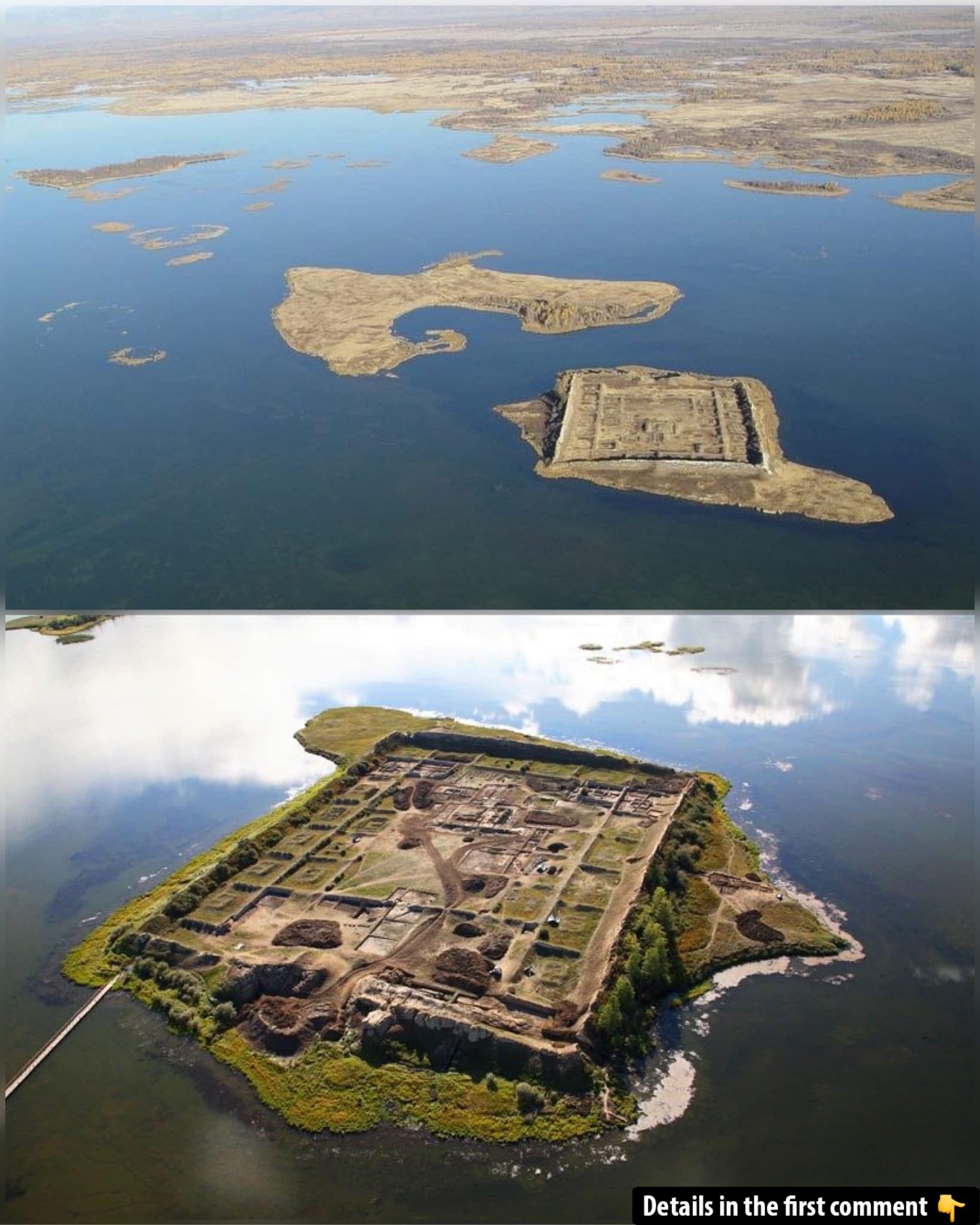The Por-Bazhyn Fortress, located on an isolated island in the remote Siberian region of Tuva, has puzzled historians and archaeologists for over a century. Despite being discovered more than 120 years ago, its purpose and origins remain one of the most enigmatic archaeological mysteries. Its unusual location, architecture, and the fact that it appears to have never been used have sparked numerous theories, but answers remain elusive. What was this structure built for, who built it, and why was it abandoned?
Discovery and Location: An Island Fortress in the Heart of Siberia
The first glimpse of the Por-Bazhyn Fortress came in 1891 when ethnologist Dmitry Klemments stumbled upon it while exploring the region. Situated on Tere-Khol Lake in Tuva, a harsh and remote area on the border of Mongolia, the fortress stands on a small island in the middle of the lake. The island’s isolation adds to the mystery of why such an imposing structure would be built in such a difficult-to-reach location, far from major settlements or trade routes.
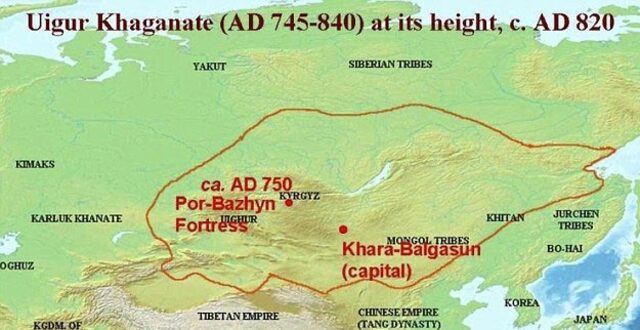
The initial discovery raised more questions than answers. Although there were several expeditions to the site over the years, it wasn’t until the late 20th century that more systematic archaeological investigations began to uncover significant findings. In the 1950s and 1960s, an archaeological team led by Professor Sevyan Vainshtein conducted excavations, revealing numerous structures behind the fortress walls, including 27 houses, a palace with intricate murals, and artifacts such as weapons and pottery. Yet, despite all these discoveries, no human remains were found, and no evidence suggested that the fortress had ever been used for its presumed purpose—defense or occupation.

Video
Check out the video on the mysterious ruins of the Island Palace of Por-Bajin – it’s a captivating exploration of ancient architecture!
Architectural Features: A Sacred and Symbolic Design
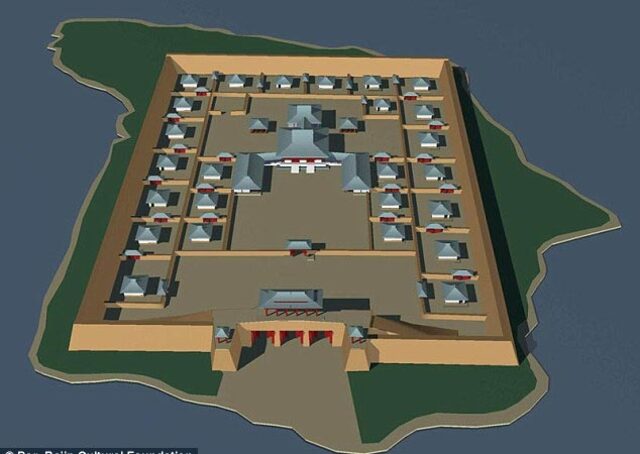
The design of the Por-Bazhyn Fortress is unlike anything previously discovered in the region. The layout of the fortress is rectangular, with a maze-like structure inside that bears striking resemblance to the mandala patterns seen in Buddhist and Hindu traditions. This unique feature led some archaeologists to speculate that the structure may have been a religious site rather than a military fortress.
The walls, which rise up to 10 meters, were once part of a grand palace complex. Remains of massive stone columns and a foundation reinforced with iron still stand, hinting at the grandeur of the original structure. In front of the eastern wall, there is evidence of a large open square, possibly used for ceremonies or gatherings, while the remaining architectural remnants point to a complex system of living quarters and public spaces.

The site is surrounded by an artificial lake, adding to its mystique. Archaeologists have found no evidence of heating systems, which would have been essential in such a cold environment, further raising questions about the true function of the fortress. With no signs of occupation or use, the structure’s original purpose remains a mystery, prompting speculation about religious or cultural practices.
Theories on Its Purpose: Fortress, Monastery, or Something Else?
The theories surrounding the Por-Bazhyn Fortress are varied and intriguing. Some suggest it was a military outpost or a checkpoint along the ancient Silk Road that connected China to Europe. However, this theory seems unlikely given the fortress’s isolated location and its lack of any connection to known trade routes. Another theory posits that it was a stronghold for bandits, who could have used the island’s seclusion to hide stolen goods or treasures, sparking rumors of hidden treasure beneath the fortress.
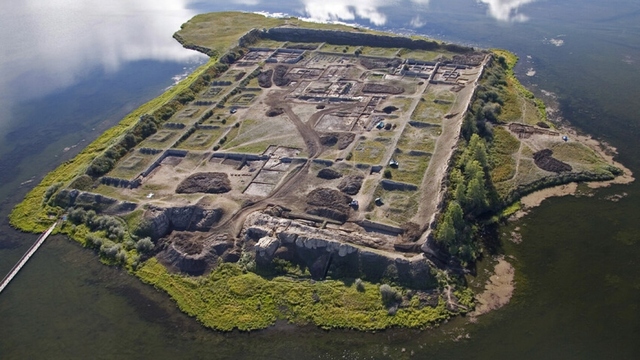
However, the most compelling theory is that Por-Bazhyn was a religious site, possibly a Buddhist or Manichaean monastery. The region of Central Asia, where Tuva is located, has long been a crossroads of various religious traditions, including Buddhism and the ancient Manichaean faith. The murals found on the walls of the fortress, with their vivid red, orange, and yellow colors, bear strong resemblances to the art found in Buddhist monasteries in Central Asia. The intricate design of the structure, along with its symbolic layout, further supports the theory that it may have been a place of worship or religious observance.
In fact, the Buddhist connection to the site is supported by further analysis of the fortress’s architecture. Tigran Mkrtychev, a Russian expert on ancient Central Asian art, noted that the arrangement of the murals and decorations is strikingly similar to those found in Buddhist monasteries in the region during the 7th and 8th centuries. It is also possible that the fortress was part of a broader religious reform during this period, when rulers in the region adopted Buddhism and sought to create centers of spiritual learning and practice.
Radiocarbon Dating and the Miyake Event: Unlocking the Timeline
Modern scientific techniques have provided valuable insights into the construction and timeline of the Por-Bazhyn Fortress. Radiocarbon dating and the use of the Miyake Event, a phenomenon caused by a massive solar flare in 775 AD, have helped narrow down the time frame in which the fortress was built.
In 2018, scientists from Russia sent wood samples from the fortress’s walls to the University of Groningen in the Netherlands for radiocarbon analysis. The results showed that the fortress was likely built during the summer of 777 AD, with construction continuing over the following two summers. This aligns with historical accounts of a ruler in the region who attempted to implement significant religious reforms, including the spread of Manichaeism, during this period.
The construction of the fortress during this time makes sense within the context of these religious reforms. However, the eventual abandonment of the fortress after a political upheaval in 779, when the ruler was overthrown and his reforms reversed, offers a plausible explanation for why the site was never used for its intended purpose.
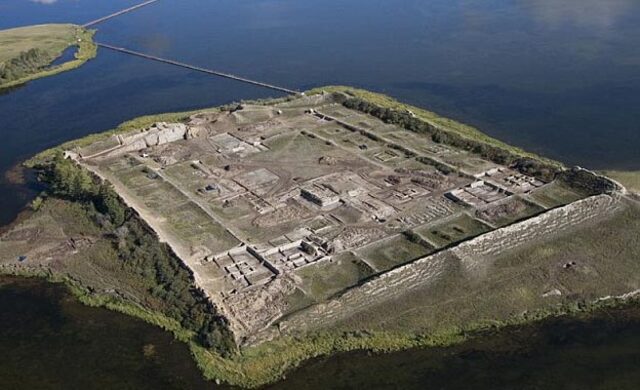
The Abandonment and Its Mysteries
Despite the clear evidence of construction, the Por-Bazhyn Fortress was abandoned before it could be used. The absence of signs of occupation, combined with the lack of any remains from the people who built it, suggests that the fortress was abandoned under mysterious circumstances. The political changes during this period, particularly the overthrow of the ruler who initiated the religious reforms, may have contributed to the abandonment. It is possible that the fortress was left unfinished or unused, as the political climate shifted and the need for such a structure dissipated.
The idea that the fortress was never used only deepens the mystery surrounding Por-Bazhyn. What happened to the people who constructed it? Why was it abandoned so abruptly? The theories of its purpose and use continue to evolve, but one thing remains clear: Por-Bazhyn is a site that offers a glimpse into the complexities of ancient religious, cultural, and political life in Central Asia.
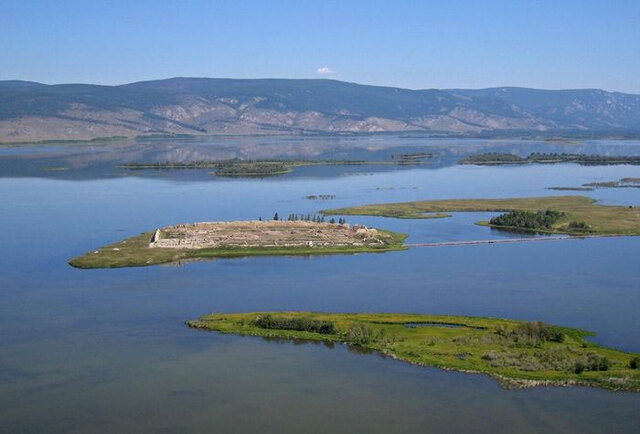
Video
Watch the video for breaking news on new insights into an 8th-century island complex on the Russian steppe – it’s an exciting discovery!
Conclusion: The Enduring Mystery of Por-Bazhyn
The Por-Bazhyn Fortress stands as a testament to the enigmatic past of Siberia and Central Asia. Its grand architecture, its isolated location, and the lack of any evidence of its use have made it a source of intrigue for archaeologists and historians alike. Whether it was a fortress, a religious site, or something else entirely, the mystery of Por-Bazhyn continues to captivate the imagination of those who seek to unravel its secrets. As more research is conducted and new technologies are employed, perhaps the true purpose of this ancient fortress will finally be revealed. Until then, Por-Bazhyn remains one of the most fascinating and unsolved archaeological puzzles of our time.
